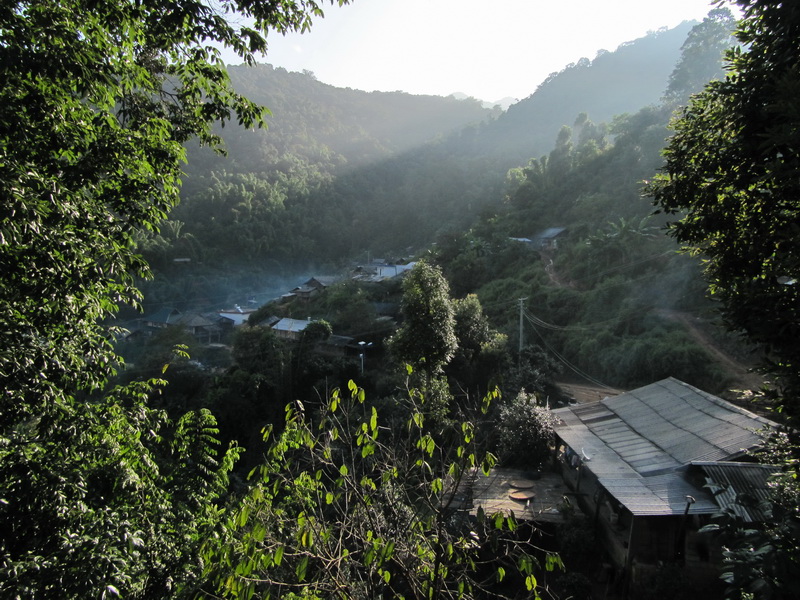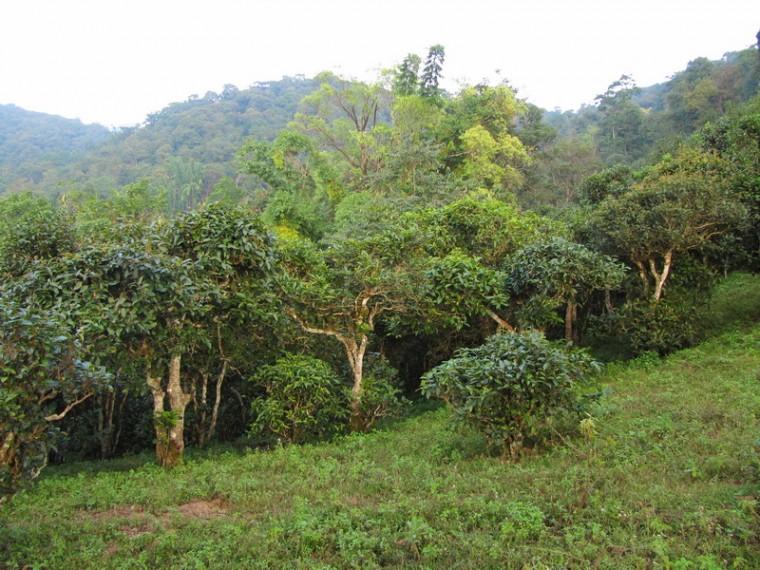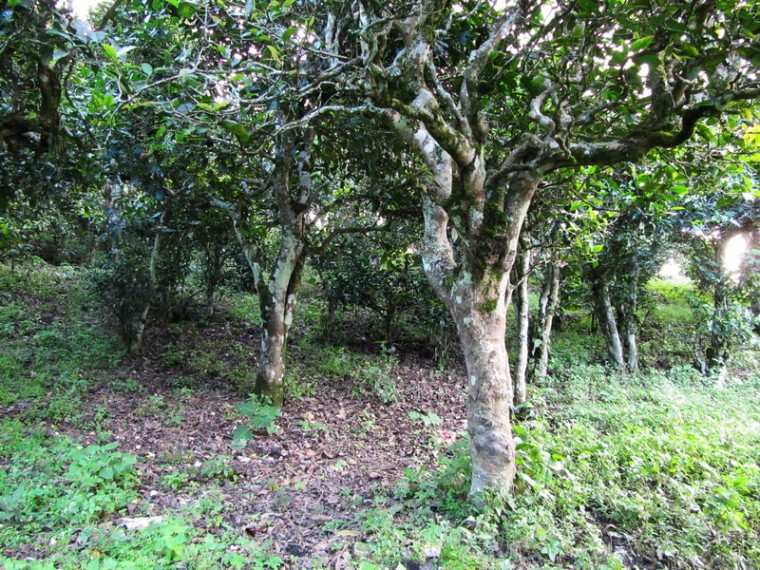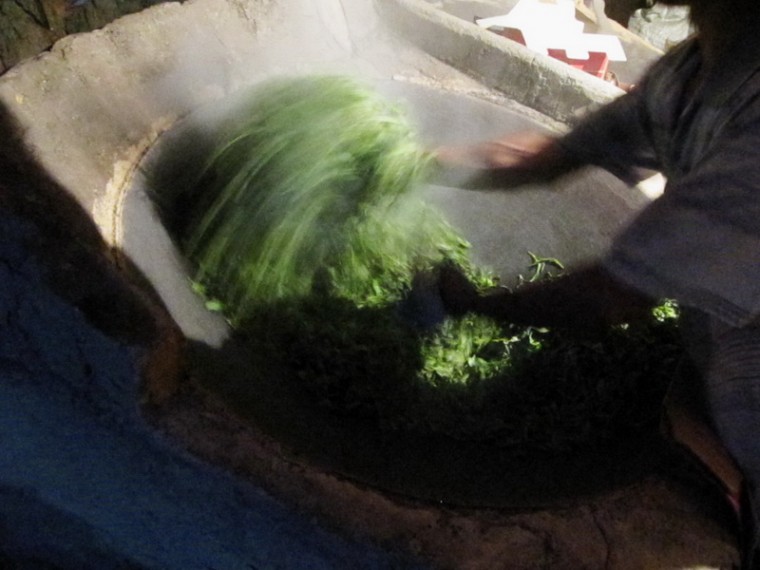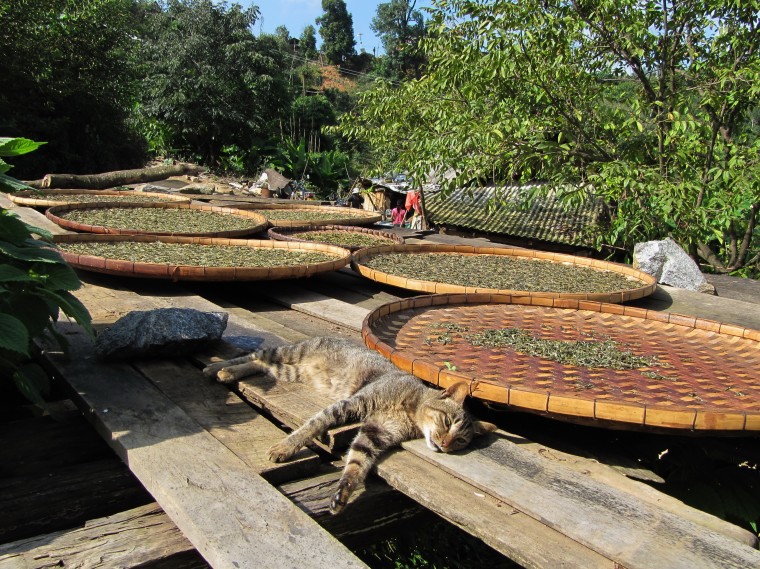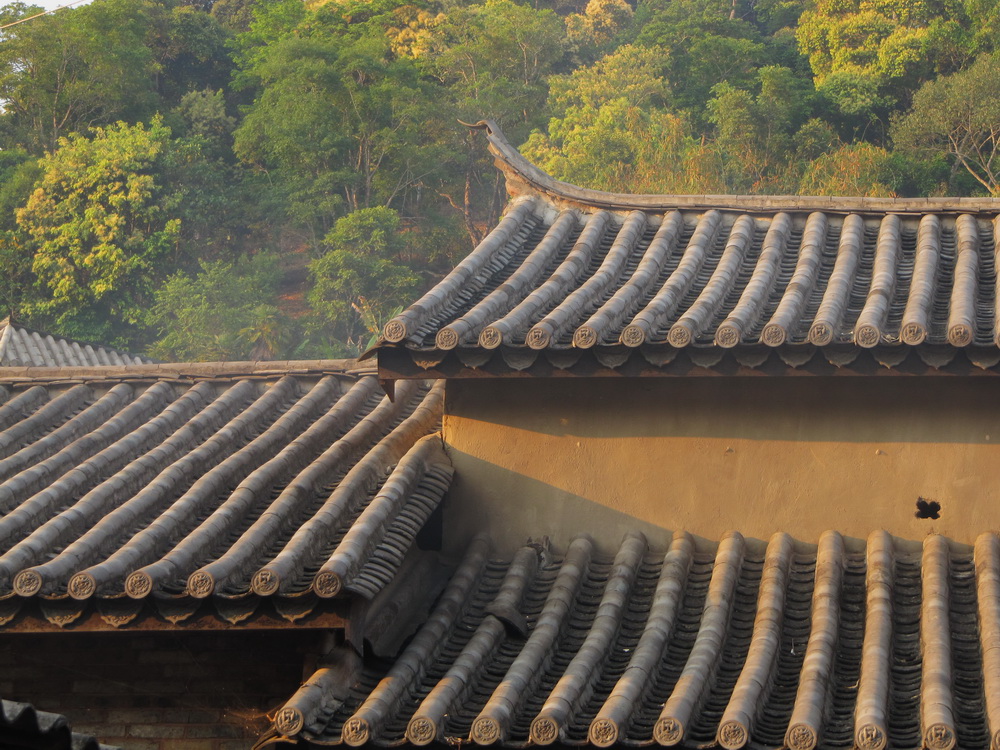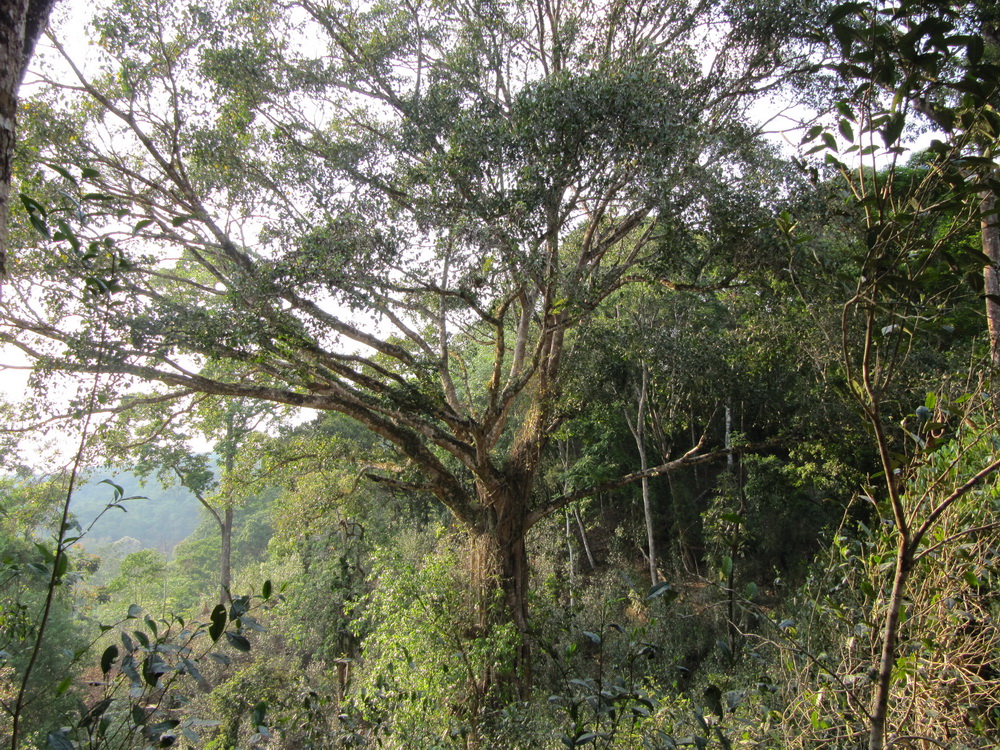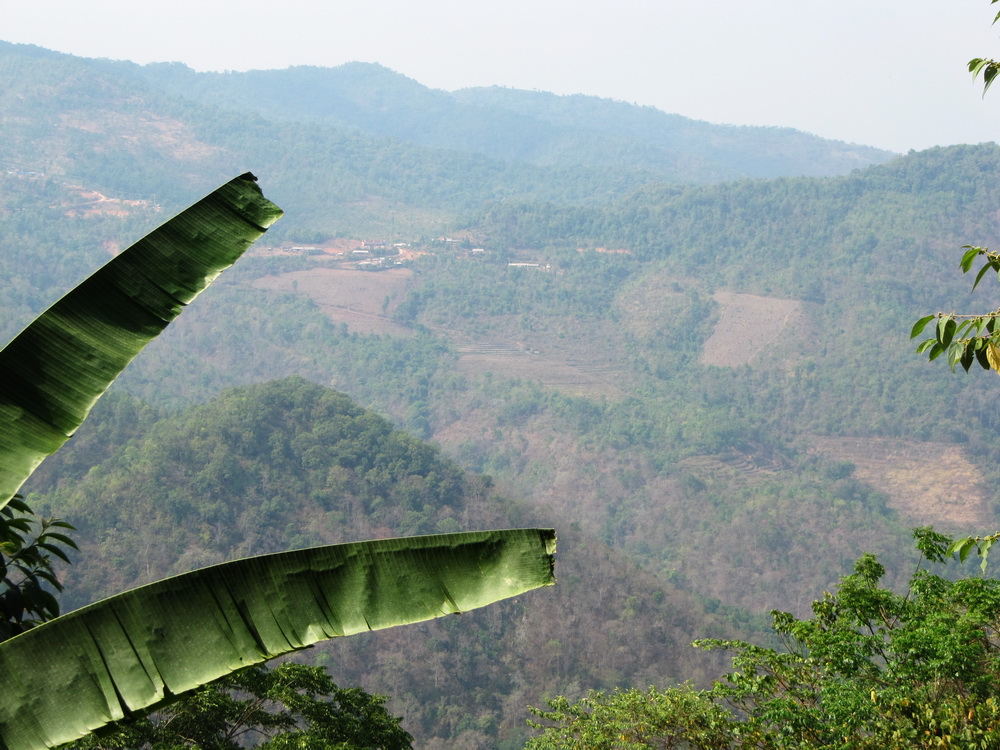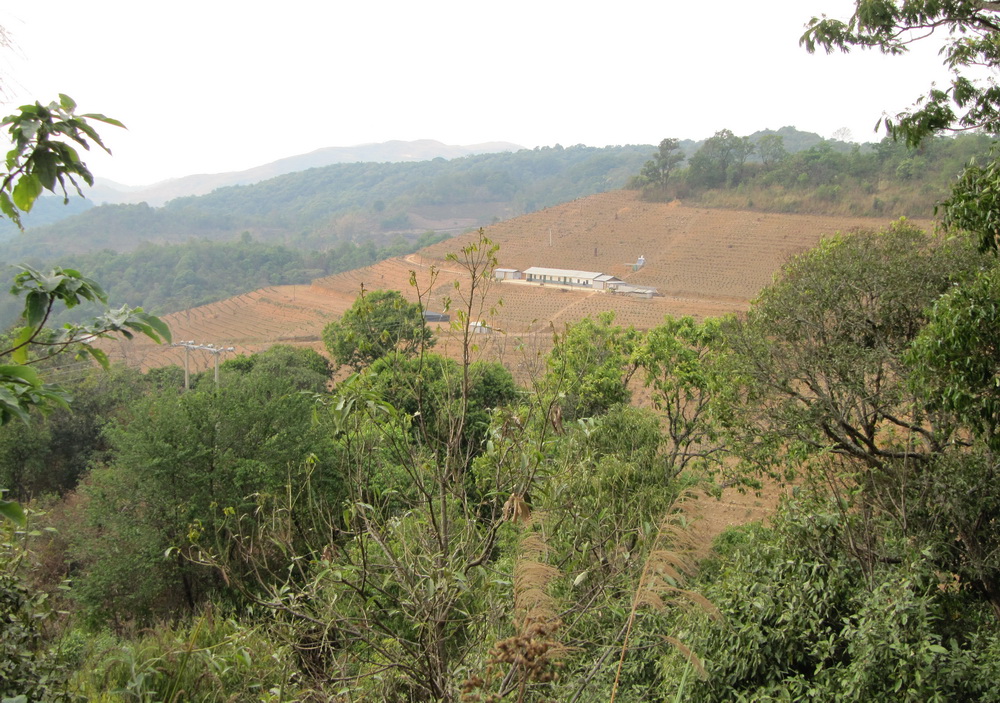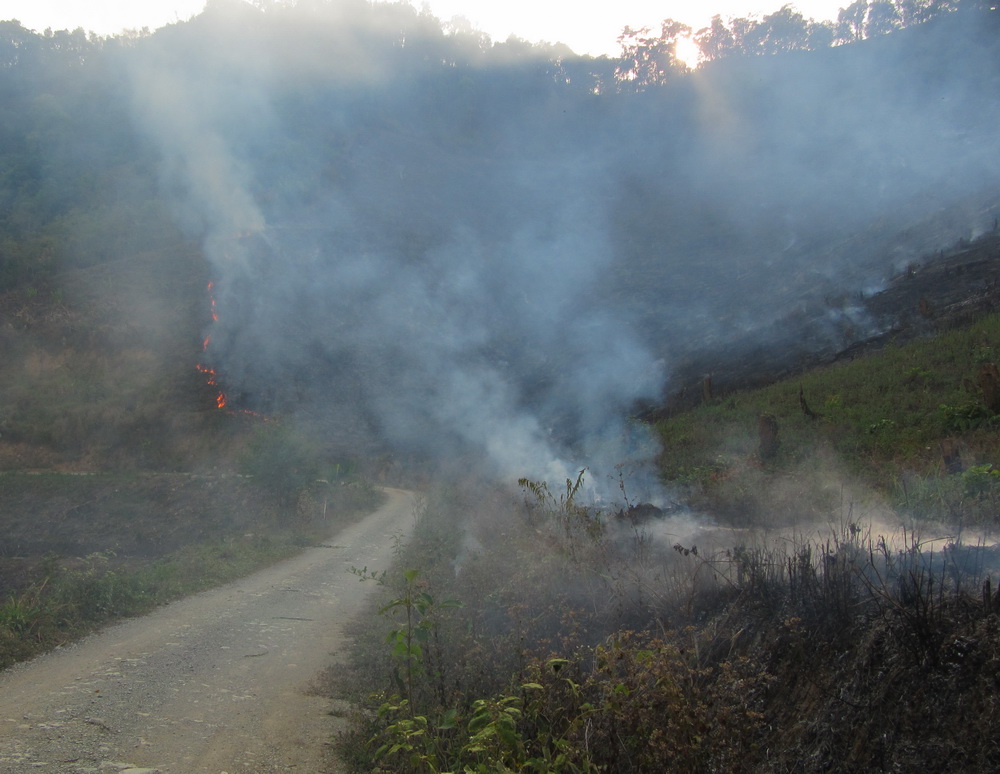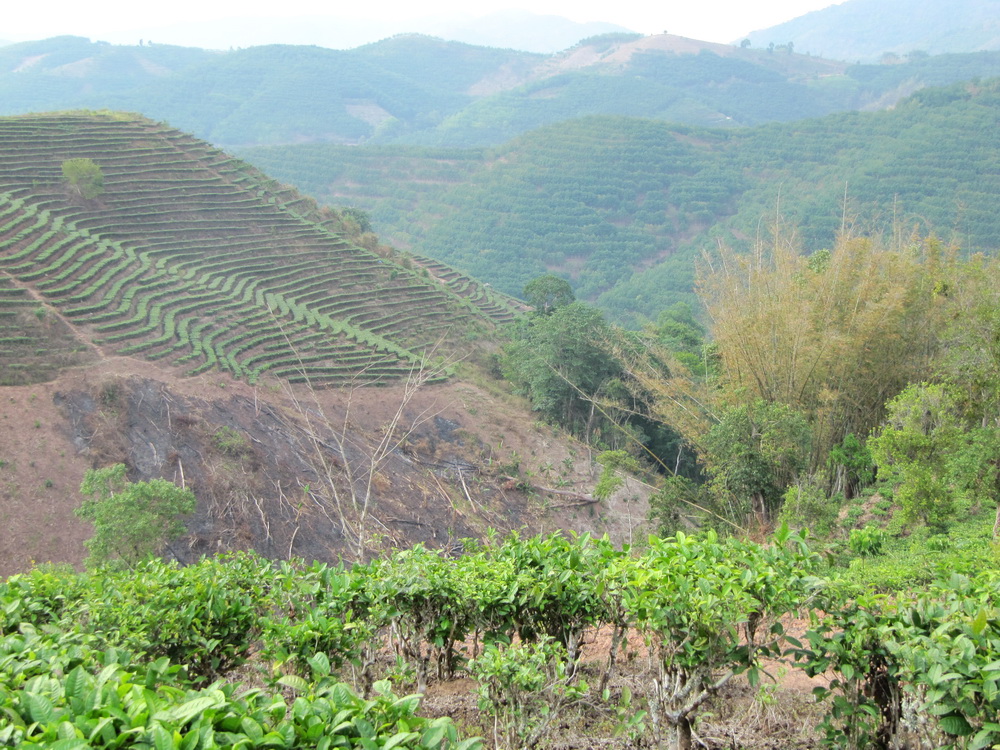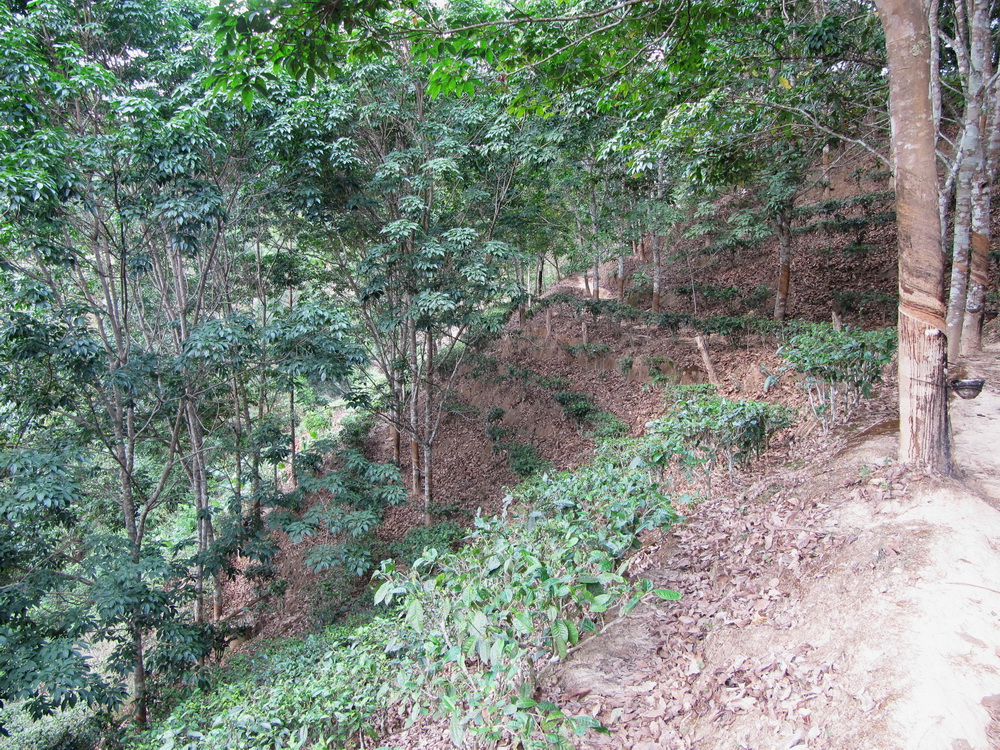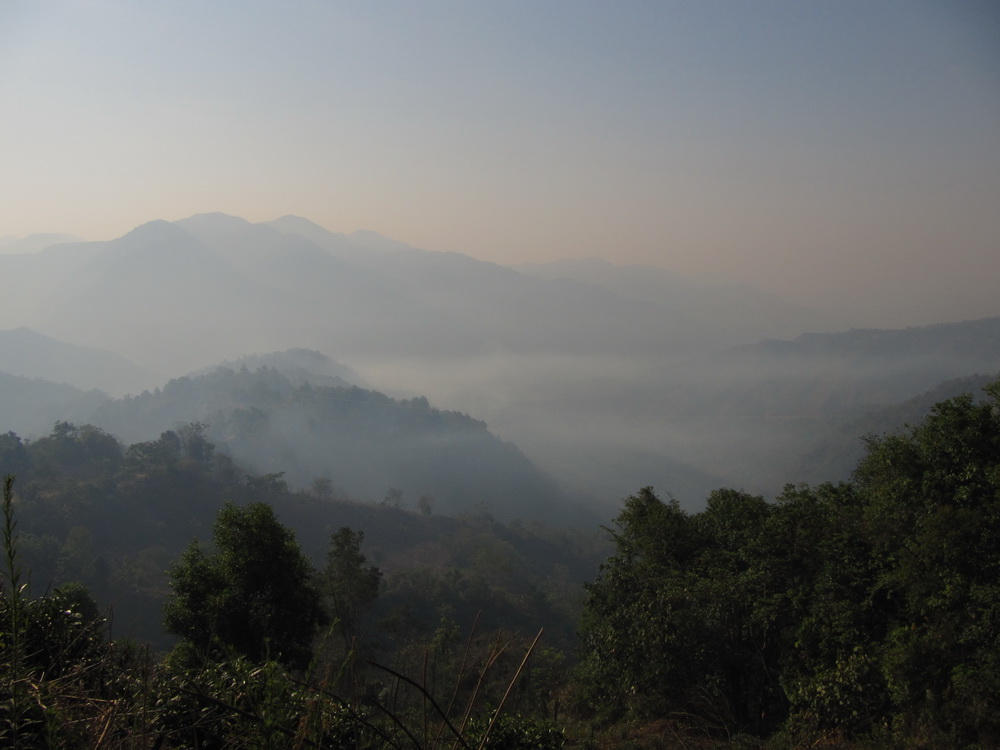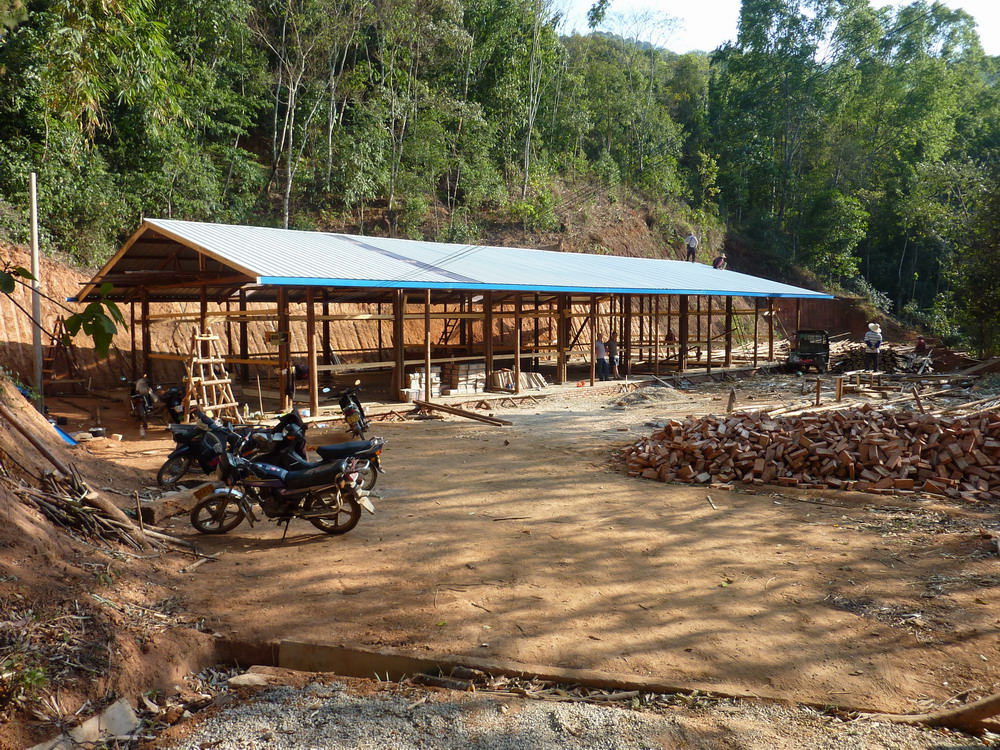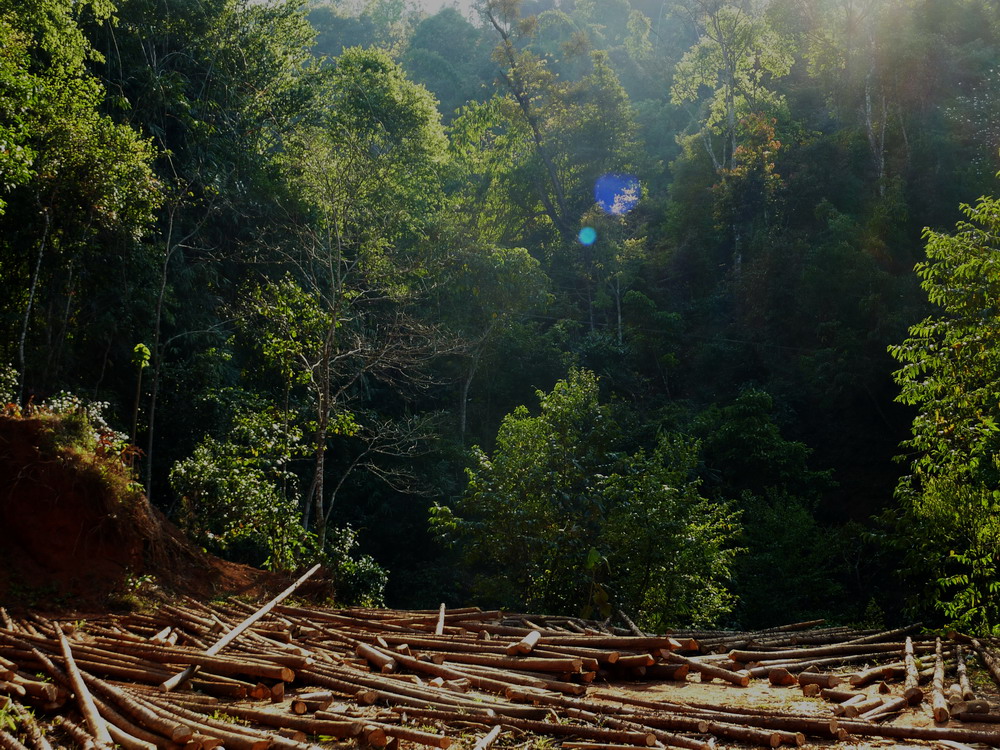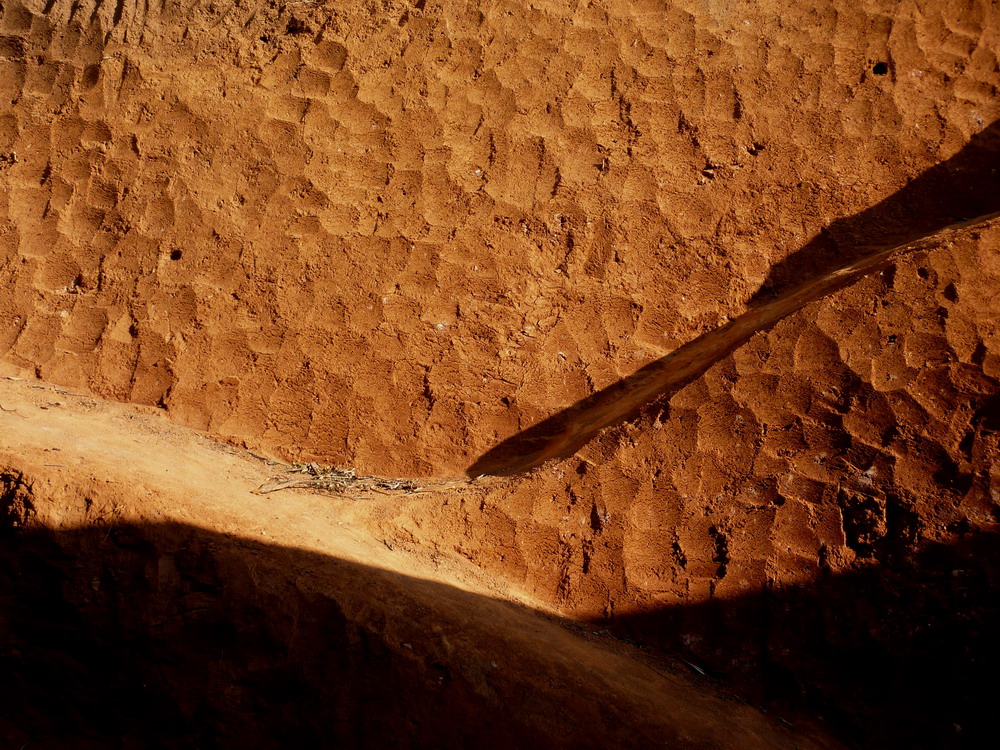Naka -(Menghai Mengsong)
Naka is a Lahu village with around 100 households above Menghai Mengsong. They have about 500 mu (33+ hectares) of old tea trees. The trees are zhong xiao ye zhong -middle small leaf variety. They distinguish between xiao shu/small trees, zhong shu/medium trees, and da shu/old trees.
Tea trees are on both the upper and lower side of the village, but most old trees are on the higher side. The village is at an altitude of 1600-1700 meters, not too far from Hua Zhu Liang Zi – Xishuangbanna’s highest peak at 2,400 metres where there is a preponderance of wild tea trees.
The village has seen substantial change in the last 20 years: electricity, a road, motorbikes. Prior to that they had tuolaji (horticultural tractors) and there was a way up to the village: even then, people found their way up there to buy tea for 7 or 8 yuan a kilo.
Tea farmers I have spoken with say that their method of tea making has not changed in the ensuing years. They make tea in the same way: ‘sha dao tou, zhong pao tiao’ – fried till it’s ‘done’ (to minimise se wei and improve the fragrance), and medium rolled*. Typical ‘/tan qing/wei diao‘ times are 3-4 hours. When I was there recently, tea was being left for rather less time due to (lack of) leaf moisture and the distance the tea was carried back to the village.
“The biggest difference” one villager told me, “was that then, nobody bothered to taste the tea. If it looked alright, they bought it. Now everybody tastes it, but they are not so concerned with how it looks.” Previously, tea was graded, but as elsewhere, no-one distinguished xiao shu, da shu, etc. The oldest trees above the village are said by villagers to be more than a thousand years old, but may be a little less – certainly in the 600 – 800 range.
A 70 year old women in the village told me that when she was a girl, they did not make tea commercially. Now, the village has a tea co-operative and most people are involved in tea making. The co-operative made around four to five hundred kilos of tea this spring. As reported elsewhere, this is substantially less than they were getting a few years ago.
I stayed with the family of the village head. There are four generations, but the younger two no longer understand their forebears’ mother tongue. They switch between pu tong hua and dialect.
*The approach of falling shy of frying tea till it’s ‘done’ – medium rare – is seemingly more and more common – in part in the belief that it will age better. Perhaps also because it is rather easy to ‘chao guo du’ – over-fry the tea, which results in a tea rather more akin to green tea than Puer, and with limited scope for aging.
Tea is also typically rolled rather less tightly than it used to be. Some people are of the belief that it is in an effort to hoodwink customers – substantial looking leaves in a cake which could erroneously convince the buyer that it was old tree material. There’s more to it than this: I know some producers who favour lightly rolled tea, but are very particular about their leaf sources.
The Good, The Bad and The Ugly – Though not particularly in that order.
Roofs of one of the older buildings in Ma Hei.
What becomes more and more apparent to me as I spend more time in the mountains, in tea villages, is the conflict that there is (and which is increasing) between the desire/need to develop rural economies, the desire/need to bring marginal groups on the geographical and societal peripheries more into the mainstream – at least to the extent they themselves wish, and to foster and protect the environment in which these people live and from which livelihoods are earned, not least through the extraction of natural resources and crop production.
Life is changing: roads are getting better, so transport and access to education are becoming easier, and incomes are increasing. Sobering that in 2003, the average farmers income in the 4 mountains area that covers Yi Bang, Mang Zhi, Man Zhuan and Ge Deng, according to government figures, was less than 1,000 yuan a year.
In the Six Famous Tea Mountains area there are ample signs of new cash crops. They are mostly restricted to lower altitude areas such as around Menglun or say the ‘white’ road (i.e. a stone road or track) from Ding Jia Zhai down to the Xiang Ming-Meng Lun Highway.
Or, as in the photo below, from the same highway up to Xiang Ming, where a sizable area has been cleared for bananas or ?? ba jiao – a variety of small banana that is often grown as much for the leaves as the fruit.
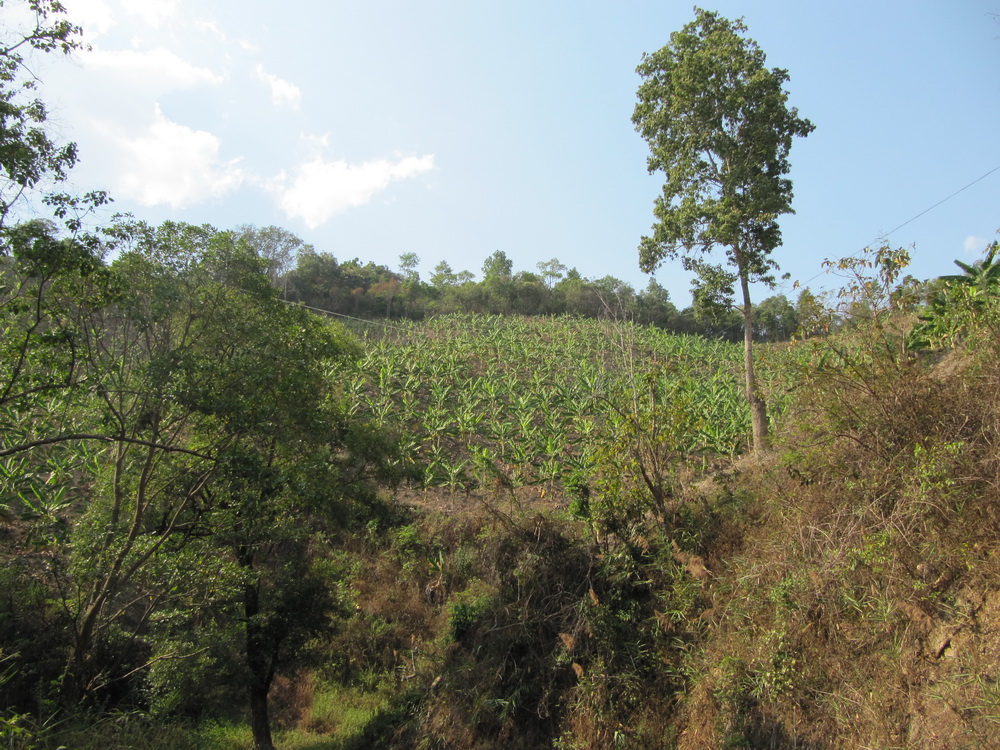
Further up, but before Xiang Ming, one arrives at Man Zhuan.
These old tea trees gardens of Man Zhuan Lao Zhai look good, healthy and the tea is good. The lack of ground cover is because of the canopy trees which provide shade and there has also been some manual weeding done around these trees. But here too there are ba jiao plantations not so far away which could cause problems if their encroachment were to continue.
There’s good bio-diversity. This particular area is noted for a magnificent – they are perhaps 50-60 metres tall – small fruited variety of fig tree called rong shu – ?? but which is not edible – for humans at least.
Through the other side of Xiang Ming you come into Man Sai – a small Dai town on the Xiang Ming- Menglun road that has a long history but which is now growing wealthy on rubber.
From here, one can turn off the main road to head up to Ge Deng. The road first winds its way up through a patchwork of rubber and banana trees. A landscape transformed on such a wide scale – with a mono-crop that is more depleting than anything that has been grown here to date. Vast swathes of land have been cleared to make way for rubber, but then, all of a sudden, you’re into some quite respectable forest. This generally occurs around the thousand meter mark.
But here too, there is clear cutting. Here’s a view from near Yang Lin looking across the valley towards Ge Deng. The land below the village, Aka Zhai, has been cleared for coffee.
A villager in An Le told me that if they produce good quality coffee, a farmer could make about 20,000 yuan/mu a year (a mu ? is 1/6 of an acre). That’s more than they’d get from bush tea, and coffee offers more predictable prices. But as with taidi/bush tea, it necessitates the use of agro-chemicals.
The real gems of Aka Zhai and Zhi Beng are on the other side of the mountain and can’t be seen in the photo above.
The photo above is of an area on the road from An Le to Hong Tu Po and shows a substantial area that has been cleared.
The photo below is from another area of the Six Famous Tea Mountains. This time cleared for maize. The clear cutting is hard to stop. One village head told me that despite government incentives to stop clear cutting it still happens and is hard to control. In any case, whatever the government incentives might be, they’re unlikely to match the incentive of a potentially significant increase in income.
Youle has a large expanse of rubber and rubber inter-cropped with tea. The road from Kong Ming Shan down to Jinuo Shan is lined with rubber interspersed with bush tea. In the photo here the area to the left and the foreground is all tea, but the hills to the right are rubber.
Or here, in a plantation which to the unwitting eye looks pleasant enough, but where the rubber trees are providing shade for the tea and the tea helps protect the rubber. That the latex ends up in someone’s condom is ok, but the tea will end up in someone’s cup too.
This kind of inter-cropping is said to have many benefits, but they are largely benefits for the rubber producer/industry rather than the tea producer. The main chemical used on rubber trees is sulphur which is sprayed on the trees to combat fungal infection and it is typically applied in early spring, say February, when the rubber trees, which have been dormant over the cool season are beginning to shoot. It may be that if there is some good rain after sulphur application and before the tea is picked, there may be minimal detrimental effect, but it’s debatable. In any case, the rubber trees will, by most accounts, deplete the soil and the water table and are hardly likely to be beneficial for the tea.
See a pro inter-cropping report here
or here for other points of view
What I didn’t photograph, but is perhaps the most obvious and visually displeasing aspect of these developing rural economies is the trash. Going into Hong Tu Po, both sides of the road are strewn with garbage for a few metres: mostly plastic bags, but also polystyrene, tin cans, bottles, etc. It’s likely not the most devastating of assaults on nature, but somehow represents a disregard for the environment.
Mountain village people are not big consumers of pre-packaged manufactured food: biscuits, soft drinks, pot noodles and what have you. One villager told me it was only in the last 2-3 years that the volume/problem has become much more acute. Apparently there is the semblance of an ad-hoc system of recycling, with people going round the villages collecting items like cans and bottles, much as they do in towns and cities in Asia, but the bags and other detritus get left behind.
It is no doubt a wider issue: both within Yunnan, and countries on its borders, that there is an ever increasing awareness, and desire for, the plentiful resources that nature has provided: lumber, minerals, fertile soil, water, but the awareness of and regard for the natural, for nature, for the environment which has produced the bounty, is lagging some way behind.
There is, of course, rhetoric. It is not uncommon to hear talk or see signs with some stock expression about looking after the environment. But the practice is a little different. And a shoulder shrugging ‘mei ban fa‘ ??? ‘No way out’ is not uncommon.
Outsiders, who come into these areas periodically and who are growing in number, are often little, if any, better, even when their world view, their background and education might have, one could assume, lead them to have a better grasp of the issues than local people in villages who may have been afforded scant access to education and information and perhaps with that, have a less perspicacious view.
The good news is that despite all of this, there are still vast areas that are largely untouched. The Liu Da Cha Shan cover an area of close on 3,000 square kilometres. That’s 1,160 square miles in old money, and in that, Yi Bang, Mang Zhi, Man Zhuan and Ge Deng alone cover more than 1,000 sq kms (386 sq miles).
March 2011
Here are a few photos of the site in Nan Nuo Shan;
The building from the entrance to the site. We acquired the piece of land after it had already been levelled, but then was left for some time. The road up the mountain passes from the left, up behind the building. The land behind and to the west is mature forest. The tin roof is the only really practical solution in this case. To make a traditional tile roof – small earthenware tiles are made outside Menghun – requires a lot more superstructure to support the tiles and, consummately, a lot more work.
Looking west from the building. The timber came from a pine plantation further up the mountain. The land falls away at the point where the lumber finishes and drops down to a small stream. The site already has mains electricity but, with some luck, we will tap the stream for a power supply using a pico-hydro unit.
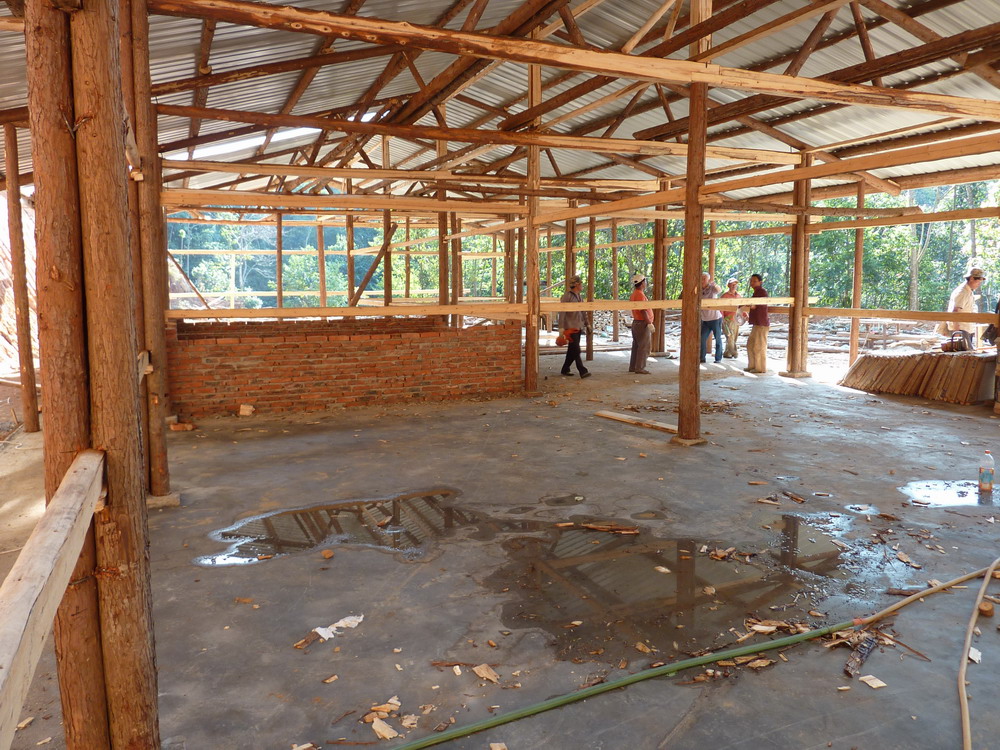 The inside of the building. A fairly traditional style timber frame on a concrete slab. The structure has been built by Aini people from Nan Nuo Shan in the way that they typically build. Not all the people on Nan Nuo are tea farmers. Some do other jobs in the area and many, including tea farmers will do other seasonal work when there is no tea being produced, so construction is something that many will turn there hand to. The brick section in the centre will provide kitchen and bathing areas.
The inside of the building. A fairly traditional style timber frame on a concrete slab. The structure has been built by Aini people from Nan Nuo Shan in the way that they typically build. Not all the people on Nan Nuo are tea farmers. Some do other jobs in the area and many, including tea farmers will do other seasonal work when there is no tea being produced, so construction is something that many will turn there hand to. The brick section in the centre will provide kitchen and bathing areas.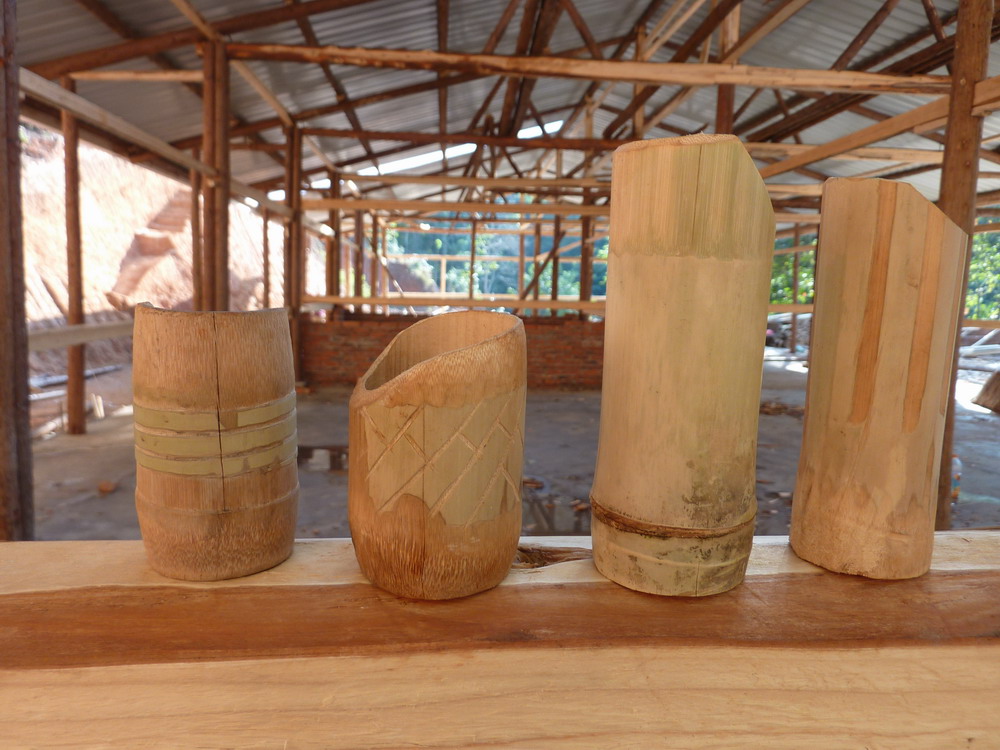 An integral part of the construction process – bamboo bai jiu cups. The bai jiu is normally made by tea farmers themselves by distilling maize in a home-made still.
An integral part of the construction process – bamboo bai jiu cups. The bai jiu is normally made by tea farmers themselves by distilling maize in a home-made still.
The bank at the back of the building. A path was cut into the bank for access.
November 2010.
Suddenly the weather has turned quite cool. We’re out of the rainy season and we are preparing to make this year’s first set of autumn cakes. The wrapper was finished today and we will start pressing cakes on friday. We’ve got some very nice tea. Autumn Puer sometimes surprises me with it’s sweetness and fragrance – of course it does not have the ‘punch’ of early spring tea, but it can still make an excellent brew and, maybe for the tea drinker who is less familiar with the world of sheng cha, it can make a perfect introduction.
Trips into the mountains, looking for tea…
December 2009.
This is the quietest time of year for us as no one picks tea in the winter months. The first Spring leaves usually come out in February. Wild tea trees generally sprout earlier than younger trees and bushes. Old trees generally flush after that.

